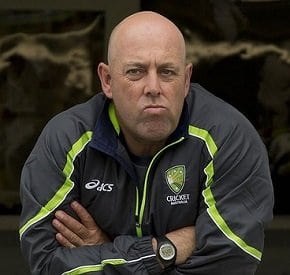Australia’s selectors are likely to revamp the top order and the bowling attack for Lord’s as coach Darren Lehmann promised to keep coming back at England after the narrow defeat at Trent Bridge.

He said the bowlers who didn’t play at Trent Bridge would be in contention to play in the Lord’s Test, which starts on Thursday.
Of those, Ryan Harris appears the most likely inclusion because of his ability to swing the ball at pace, while Mitchell Starc, who had a purple patch with two wickets in two balls in the second innings but also had erratic moments, could miss out.
Mitchell Johnson infamously lost his radar in 2009 at Lord’s, where accuracy is all-important because of the slope of the ground. Jackson Bird, renowned for his control, is another appealing option.
Cowan edged wafting cover drives in both innings, for a golden duck and 14, departing from the defensive role for which he was picked. ‘He’ll be disappointed with the shots. So are we,’ Lehmann said.
‘He had a tough game. Like everyone’s position, you’ve got to make runs and perform. So we’ll sit down as a selection panel over the next couple of days and work out what we think is the best XI to play the next Test match and work from there … you’ve got to make runs.’
David Warner was due to join the Australia A tour in Zimbabwe on Tuesday, and there are no plans to draft an extra batsman into the squad in his absence.
Usman Khawaja is a natural replacement at No. 3 but Lehmann also raised the possibility of dropping a batsman and picking five specialist bowlers.
The pitches in England are so dry this summer – Trent Bridge reminded England batsman Ian Bell of the subcontinent – that the selectors have even discussed picking two spinners, in Ashton Agar and Nathan Lyon.
Agar’s dream debut yielded 2-82 from 35 overs in the second innings and 98 in his maiden Test innings, which put a full stop to his illustrious career as a No.11.
‘There’s been talk about it. But until we see the conditions, it’s hard to say,’ Lehmann said. ‘You might go in a batter light and play five bowlers. I’m not worried about that. You just pick the best way to get 20 wickets. That’s the key. We know we’ve got to get 20 to win the Test match. We did it here and just missed out. We’ve got to back it up and do it at Lord’s. If we think two spinners is the right way to go, we’ll do that.’
Australia’s unhealthy dependence on the last-wicket partnership is not new. In 17 Tests since the start of last year, the 10th wicket has added 686 runs at an average of 40.35.
‘Our tail has done really well over a long period of time now but it’s time for the batters to make sure they’re making the runs and giving the tail a bit more time,’ Lehmann said. ‘I think we only batted for 63 overs in the first innings and 110 today. We’ve got to be reversing that about, batting for 120 overs-plus in the first innings of a game and making our runs then.’
England have their own concerns, including an unhealthy reliance on Jimmy Anderson, who was heroic with 10 wickets for the match. Steven Finn was taken apart by Brad Haddin, and could lose his place to either Tim Bresnan or Graham Onions, who were named in an unchanged 13-man squad.

